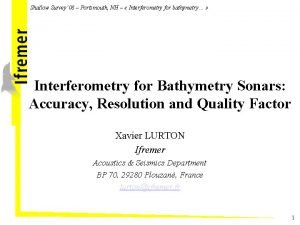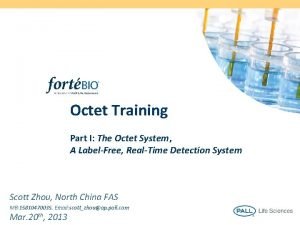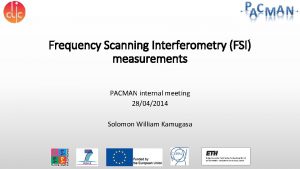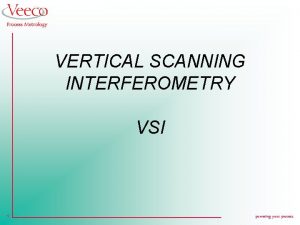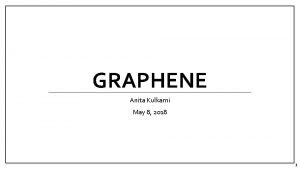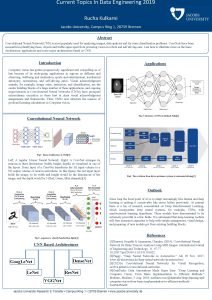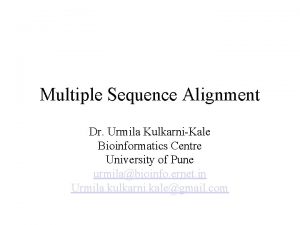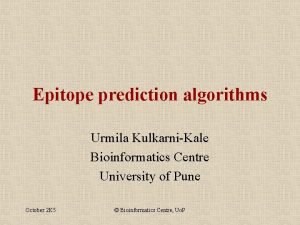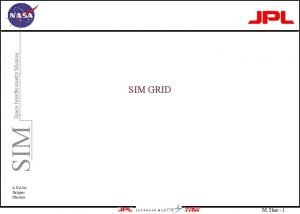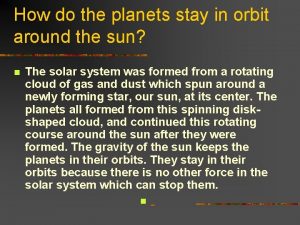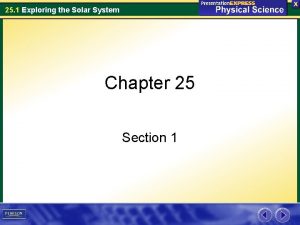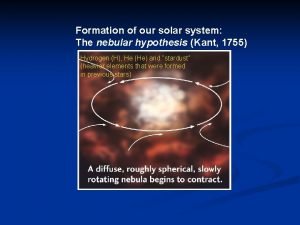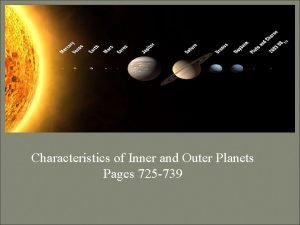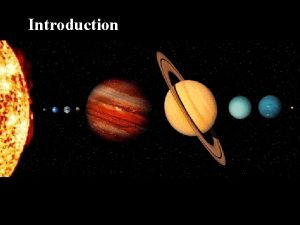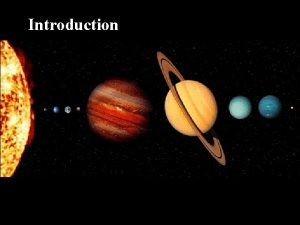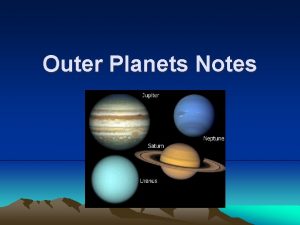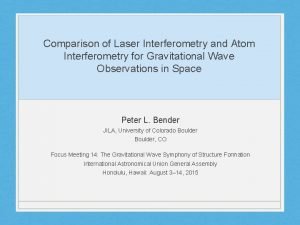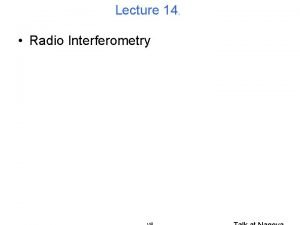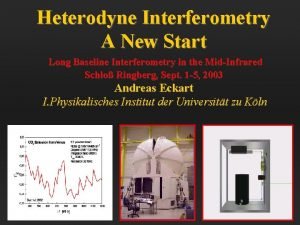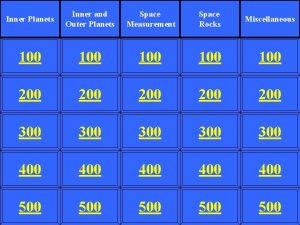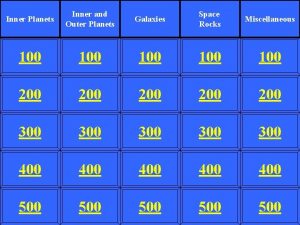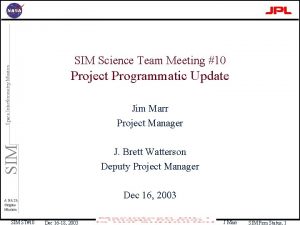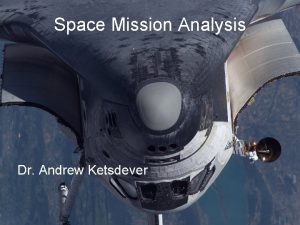Space Interferometry Mission Planets More S R Kulkarni












































- Slides: 44

Space Interferometry Mission: Planets & More S. R. Kulkarni California Insitute of Technology

Key Goals • • Inventory of Extra-solar planets Search for terrestrial mass planets Accurate Cosmic Distance Scale Measure the Age of the Universe Determine Mass & Matter Makeup of Galaxy Fundamental Stellar Astronomy Define Fundamental Astrometric Frame

SIM: Modes • Wide Angle Astrometry: Distance & Dynamics position (ra, dec) & proper motion: 4 microarcsec • Narrow Angle Astrometry: Planets angular difference: 1 microarcsecond (These are the precision to be achieved by end of mission)

The Distance & Age Scale • Cepheid distance to 1% • RR Lyrae stars in globular clusters Turnoff stars & estimate cluster age • Rotational parallaxes to nearby galaxes

Dynamics of Galaxies Dark Matter and Merger History • Gravitational potential of Milky Way - 3 -d velocities of targets (to 100 kpc) tidal streams • Dynamics of Local group and nearby galaxies - proper motion of V=16 -20 mag stars

SIM: A Michelson Interferometer Three Colinear Fixed Baseline Interferometers Baseline: Wavelength: Aperture: Field of View: Resolution: 10 m 0. 4 -1 micron (CCD) 0. 3 m 0. 3 arcsecond 10 milliarcsecond Orbit: Launch: Lifetime: Earth Trailing (SIRTF) 2009 5 yr (10 yr? )

How does SIM work? Basic Interferometry Equation: Delay = B. s + C B = baseline s = source direction C = instrumental constant Stabilize with 2 grid stars observed with “guide” interferometers Measure B from observations of grid stars Measure Delay with “science” interferometers http: //planetquest. jpl. nasa. gov/simcraft/sim_frames. html

SIM & Son of SIM • 36 external metrology beams • 9 m deployed boom (for external metrology) • 7 siderostats/telescopes 1 m to 10 m baseline • Beam switchyard to combine any 2 telescopes • 4 astrometric beam combiners, 1 nulling combiner • 15 external metrology beams (simpler because they’re not deployed) • No deployed boom • 4 siderostats (8 telescopes) • 10 m baseline only, for science • No Beam switchyard • No nulling beam combiner http: //planetquest. jpl. nasa. gov/simcra ft/sim_frames. html

Rescoped Capabilities • Requirement: 30 microarcsecond Goal: 4 microarcsecond • Narrow Angle Astrometry Requirement: 3 microarcsecond Goal: 1 microarcsecond • Wide Angle Astrometry LOST Capabilities Imaging (no variable baselines) Nulling

Reference Frame: Critical SIM Frame: 3, 000 metal poor K giants Tile: 15 degree diameter “Field of Regard” (FOR) or Tile Overlap: 12 stars in any FOR Grid Campaigns: 25% of mission lifetime

The 15 -degree SIM Field of Regard is large enough to include most of Orion. A set of measurements within the same field of regard, about an hour long, forms a “tile. ” The bright star on the upper left is the red giant Betelgeuse. Red giants will form the grid of 1302 stars whose positions will be used to assess the attitude and length of the science baseline during each “tile”.

Wide Angle: Comparison

Narrow Angle Astrometry Measure REFERENCE-TARGET angle Ideally, REFERENCE star will be: - Bright (10 mag) - Close on sky (avoid field errors) - must lack planets

Planet Detection: Comparison Detection Limits SIM: 1 as over 5 years (mission lifetime) Keck Interferometer: 20 as over 10 years

Astrometry Yields All Orbital Parameters 1 A. U. ~ 150, 000 km ~80 A. U. Orbital Parameter Planetary Property Mass Semimajor axis Eccentricity Orbit Inclination Period (coplanarity) atmosphere? temperature variation of temp

Reference Stars: Requirements Reference stars should not have planets! Moderate distance K giants (mini-grid) or Eccentric Binaries

Reference Star: K giants Considerable Preparatory Work: Identification & Stability

Reference Stars: Eccentric G star binaries Eccentric binaries do not possess planets over a range of orbital separation. Risk: Uneasy Feeling

Accuracy & Precision • 1 as ( 5 picoradian) is 50 picometers. - No mechanical structure is this accurate or even this stable. - No optical surface is this accurate. • SIM achieves the required precision: – Metrology (measures changes in the optical bench) – Calibration (to remove biases due to imperfect optics) - Rapid Chopping (30 to 60 sec) to overcome thermal instability

Planet Detection: Comparison Photo Hip. 100 mas 10 mas CCD 1 mas PTI FAME KI GAIA 100 µas 10 µas SIM Single measurement accuracy 1 µas • SIM has highest sensitivity (fainter targets) • SIM is a pointed spacecraft - optimize for planet detection/orbit determination • GAIA (FAME) are scanner • End of Mission precision for SIM is 20 times better than GAIA

SIM Science Team Name Dr, Geoffrey Marcy Dr. Michael Shao Dr. Charles Beichman Dr. Todd Henry Dr. Steven Majewski Dr. Brian Chaboyer Dr. Andrew Gould Dr. Edward Shaya Dr. Kenneth Johnston Dr. Ann Wehrle Institution University of California, Berkeley NASA/JP (science team chair) NASA/JPL Georgia State University of Virginia Dartmouth College Ohio State University Raytheon ITSS Corporation U. S. Naval Observatory NASA/JPL Key Project Planetary Systems Extrasolar Planets (EPIc. S) Young Planetary Systems and Stars Stellar Mass-Luminosity Relation Measuring the Milky Way Pop II & Globular Clusters (Age) Astrometric Micro-Lensing Dynamic Observations of Galaxies Reference Frame-Tie Objects Active Galactic Nuclei Mission Scientists Dr. Guy Worthey Dr. Andreas Quirrenbach Dr. Stuart Shaklan Dr. Shrinivas Kulkarni Dr. Ronald Allen Washington State University of California, San Diego JPL California Institute of Technology Space Telescope Science Institute Education & Public Outreach Scientist Data Scientist Instrument Scientist Interdisciplinary Scientist Imaging and Nulling Scientist

Knowledge and Ignorance of Extrasolar Planets What we know: Eccentric orbits are common: scattering? – Several multiple systems of giant planets are known – Mass distribution extends below Saturn mass – Giant-Planet occurrence is high: ~7%

Knowledge and Ignorance of Extrasolar Planets • What we don’t know – Existence of terrestrial planets – Planetary system architecture – Mass distribution • Coplanarity of orbits, eccentricities • Only astrometry measures the mass of a planet unambiguously – Low-mass planets (rocky) in ‘habitable zone’ ?

EPIcs: A two-pronged search Known extra-solar system planets (7%) are different (orbital period and eccentricity distribution) Two possibilities: • Solar System is unique. • Planetary Systems are ubiquitous BUT diverse Tier 1 -Tier Program 100 nearby stars at 1. 5 microarcsec 1000 nearby stars at 4 microarcsec

Extra-solar Planet Interferometric Survey (EPIc. S) M. Shao & S. R. Kulkarni (Co-PI) S. Baliunas A. Boden D. Lin T. Loredo D. Queloz S. Shaklan S. Tremaine A. Wolszczan C. Beichman D. Kirkpatrick D. Stevenson S. Unwin C. Gelino just joined http: //www. astro. caltech. edu/~srk

Tier-1: Search for Terrestrial Planets ~ 100 of the nearest stars (FGK) • Habitable zone • Sensitivity: ~3 Me

Tier-2 Sample 1000 stars in approx. 30 -pc radius • • • Span the spectral range Span range of ages Span range of metallicty Span range of debris disks (SIRTF) Binary Stars

Tier-2 Addresses Broad Issues • What is the mass function of planets? • How is composition related to mass? [sub-Jupiters, super. Ganymede] • How common are terrestrial planets? • How does the presence of planet affect others? • How do properties of planetary systems depend on the nature of their host stars?

SIM’s anticipated Contribution • First terrestrial planets (within 10 pc) • Comprehensive view of planetary architecture • Unambiguous masses of known planets • Planetary Demographics • Reconnaissance for TPF – Specific targets for TPF around nearby stars – Target masses known (needed to calculate planet density)

Interdisciplinary Program S. R. Kulkarni (PI), B. Hansen, E. S. Phinney, M. H. van Kerkwijk, G. Vasisht Goals: • Planets around white dwarfs • Masses of neutron stars and black holes • Distances (hence radii) of neutron stars (e. g. Cen X-4) • Origin of high latitude OB stars & velocity kicks • Frame tie between SIM and ecliptic coordinate system

Now! • Palomar Testbed Interferometer Development of Phase referencing (B. Lane Ph. D) M-dwarf diameters Cepheid Pulsations • Keck Interferometer Fundamental Stellar Astronomy (Comm. Team) • Binaries: Very Narrow Angle Interferometry Adaptive Optics Precision Radial Velocity

Astrometry: Regimes

Very Narrow Angle Astrometry Shao & Colavita


The Gl 569 System • Apparent binary star system located at a distance of 9. 8 pc • Primary is a M 0 V • Companion located ~5 arcsec away. Appears to be late-M type.


The Orbit of Gl 569 B P = 892 ± 25 d a = 0. 90 ± 0. 02 AU e = 0. 32 ± 0. 02 i = 34 ± 3 deg Residuals ~ 2 mas

The Total Mass of the System • From the period and semi-major axis we can determine the total mass of the Ba. Bb pair to high precision • 3 upper mass limit for the pair is 0. 148 Solar masses

Palomar Testbed Interferometer • 100 -m baseline, 40 -cm siderostats • H, K bands • Highlights: M dwarf diameter determination Pulsations of Cepheid variable Herbig Ae/Be star

Distance to Pleiades via Atlas X-P Pan, M. Shao & S. Kulkarni (Nature, negotiating with Editor) • Pleiades is a gold standard for intermediate mass stars, brown dwarfs and Cepheid distance scale • Hipparcos team published distance to Pleiades D = 118 +/- 4 pc • Traditional distance (color-mag diagram) D = 131 +/- 3 pc Hipparcos result generated “lively” controversy.

Orbit of Atlas (Mark III & PTI) P(orbit)= 291 day a = 13 mas e = 0. 245 Inclination=108 d

Distance via Kepler’s 3 rd law A 3 = d 3 a 3= (m 1+m 2)P 2

Search for Planets in Speckle Binaries • Lane and Mutterspaugh have demonstrated very narrow angle astrometry with PTI (fringe scanning) • We are starting a 3 -yr survey to search astrometrically for planets -> achieved 20 microarcsec • Konacki has successfully achieved 10 m/s RV for binary stars with HIRES

IR Spectroscopy Resulting spectral types: M 8. 5 and M 9
 More more more i want more more more more we praise you
More more more i want more more more more we praise you More more more i want more more more more we praise you
More more more i want more more more more we praise you Inner terrestrial planets
Inner terrestrial planets First outer planet
First outer planet How are terrestrial planets different from jovian planets?
How are terrestrial planets different from jovian planets? What separates inner and outer planets
What separates inner and outer planets What separates the inner planets and outer planets
What separates the inner planets and outer planets Interferometry
Interferometry Biolayer interferometry 原理
Biolayer interferometry 原理 Frequency scanning interferometry
Frequency scanning interferometry Vertical scanning interferometry
Vertical scanning interferometry Dr anita kulkarni
Dr anita kulkarni Saili kulkarni
Saili kulkarni Rucha kulkarni jacobs university
Rucha kulkarni jacobs university Uma kulkarni
Uma kulkarni Dr. urmila kulkarni-kale
Dr. urmila kulkarni-kale Amba kulkarni
Amba kulkarni Silas kulkarni
Silas kulkarni Maha shivani
Maha shivani Dr. urmila kulkarni-kale
Dr. urmila kulkarni-kale Dr anil kulkarni
Dr anil kulkarni Space mission sims 4
Space mission sims 4 Aspire not to have more but to be more
Aspire not to have more but to be more More choices more chances
More choices more chances Newton's law
Newton's law Human history becomes more and more a race
Human history becomes more and more a race The more you take the more you leave behind
The more you take the more you leave behind Knowing more remembering more
Knowing more remembering more The more you study the more you learn
The more you study the more you learn More love to thee o lord
More love to thee o lord World space to screen space
World space to screen space Space junk the space age began
Space junk the space age began Camera space to world space
Camera space to world space Cartesian space vs joint space
Cartesian space vs joint space Cartesian space trajectory planning
Cartesian space trajectory planning How do the planets stay in orbit
How do the planets stay in orbit Circumbinary planets
Circumbinary planets What two factors combine to keep the planets in orbit?
What two factors combine to keep the planets in orbit? Inner planets
Inner planets Solar system planets
Solar system planets Juvian planets
Juvian planets Planets. lesson 1
Planets. lesson 1 Is josiah a dwarf
Is josiah a dwarf Is mercury an inner or outer planet
Is mercury an inner or outer planet Inner planets
Inner planets







